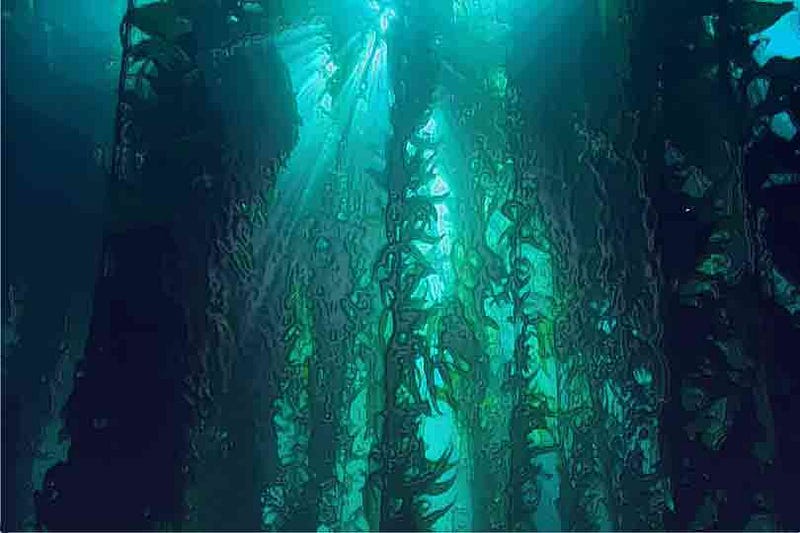# Kelp: The Future of Sustainable Farming and Climate Solutions
Written on
Kelp Farming: A New Agricultural Frontier
Imagine a farmer who doesn’t toil in fields or tend to livestock but instead navigates the open sea. This is the vision of Louis Pelton, who is pioneering the future of agriculture through kelp farming. Rather than capturing fish from crowded enclosures, Louis focuses on cultivating algae—an essential resource for both the ocean and traditional farming. His kelp not only nourishes marine ecosystems but also provides valuable supplements for terrestrial agriculture.

Kelp: The Giants of the Ocean
When one thinks of algae, images of murky ponds or harmful blooms may come to mind. However, kelp represents a different story. Known as the "sequoias of the sea," the giant kelp species can grow up to 175 feet tall under optimal conditions. These majestic underwater forests are vital to coastal ecosystems, stretching from Southern California up to Santa Cruz.
Kelp operates without roots, securing itself to the seafloor through a structure called a "holdfast." This allows it to grow rapidly—sometimes at a rate of up to two feet daily. The buoyancy of gas-filled pods attached to each blade keeps the kelp upright, allowing it to thrive in the ocean's currents.
Marine Biodiversity and Kelp
Kelp forests are home to a diverse array of marine life. Numerous species depend on these habitats for survival, from gray whales raising their young to sea otters hunting among the kelp. The intricate relationship between kelp and marine biodiversity underscores its importance in the oceanic ecosystem.
The Growing Market for Kelp
Who consumes kelp, you may wonder? Surprisingly, the market for this marine resource is larger than anticipated, and it continues to expand. Kelp is a popular ingredient in health supplements, animal feed, shampoos, and even salad dressings. Each year, California harvests around 150,000 tons of kelp, but future farmers like Louis aim to increase both harvests and markets, including innovative uses like cattle feed.
Cows and Climate Change: A Rising Concern
Globally, cattle populations are substantial, with cows producing significant amounts of methane—a potent greenhouse gas. In 2018 alone, the world consumed an astounding 61 million metric tons of beef, with the U.S. contributing a hefty 21%. As beef demand rises, so do methane emissions, which account for about one-third of the total methane produced by human activities.
However, research indicates that integrating kelp into cattle feed can reduce methane emissions by an impressive 60%. Given that livestock emissions equate to the warming potential of 7 gigatons of CO2 annually, harnessing kelp could be pivotal in mitigating climate change.
The Role of Kelp in Carbon Sequestration
Kelp forests not only support marine life but also play a crucial role in carbon sequestration. These underwater plants absorb carbon dioxide from ocean waters, utilizing it for photosynthesis while releasing oxygen as a by-product. This process helps maintain well-oxygenated waters and reduces ocean acidity, benefiting a variety of marine organisms.
When CO2 enters the ocean, it can lead to acidification, threatening species at the base of the food chain, such as plankton. By lowering ocean acidity, kelp supports a healthier ecosystem, ensuring that all marine life thrives.
Innovative Kelp Farming Techniques
Harvesting kelp involves trimming the top sections while allowing the plant to regrow, ensuring sustainability. California has regulations in place to maintain these vital ecosystems. However, innovative farming techniques are emerging. For example, a new experimental kelp elevator off the California coast allows kelp to be suspended near the surface during the day for sunlight, then lowered at night to absorb nutrients from deeper waters. This method can increase growth rates significantly.
The Future of Kelp Farming
Kelp represents a valuable resource, both environmentally and commercially. By maintaining existing kelp forests and exploring new farming methods, we can create sustainable ecosystems that benefit everyone. As climate change becomes an increasingly pressing issue, kelp farming may emerge as a profitable and essential industry for future generations.
For further reading, check out Medium publications like EarthSphere and Dropstone.
Sources:
- California kelp forests: Ecosystems in distress (Source: ArcheanWeb)
- Hot ocean waters affecting New Zealand kelp (Source: ArcheanWeb)
- Giant Kelp (Macrocystis pyrifera) (Source: Oceana)
- California’s critical kelp forests are disappearing in a warming world. Can they be saved? (By Todd Woody; National Geographic)
- How do people use kelp? (Source: NOAA)
- Seaweed could make cows burp less methane and cut their carbon hoofprint (By: James Temple; MIT Technology Review)
- Giant Kelp (Source: California DFG)
- World Beef Consumption: Ranking Of Countries (By Rob Cook; Beef2Live)
- Beef Cows inventory (Source: USDA)
- Methane, explained (By ALEJANDRA BORUNDA; National Geographic)
- Methane Tracker 2020 (Source: IEA)
- Water scarcity and fish imperilment driven by beef production (By Brian D. Richter et al.; Nature)